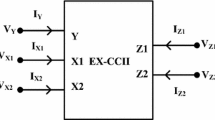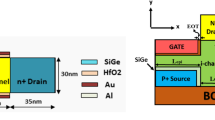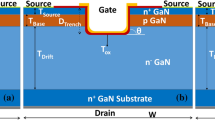Abstract
A novel, more competent, low leakage and comparatively high speed full-wave centre-tapped rectifier is introduced with minimum distortion. Proficient and exploratory combinations of PMOS–PMOS or NMOS–NMOS logic are utilized to design full-wave centre-tapped rectifier. The scrupulous PMOS–PMOS logic with augmented stacked NMOS transistor is communal form of two PMOS and one NMOS transistor. The main motive of manipulating these circuits is to maintain the substrate biasing during circuit operation. The substrate biasing refers the exploitation in which substrate and drain/source terminal of a transistor is kept in reverse biasing mode. Due to utilization of modified MOS structure after replacing of diode, efficiency of full-wave centre-tapped rectifier is increased up to 20 % with compare to p-n junction diode based full wave centre-tapped rectifier and leakage power dissipation is reduced up to 57 %. The proposed circuit is designed to utilize the body effect properly to reduce the total leakage power of the circuit. The novelty of proposed circuit is the uniqueness of combination of MOS. Due to this; the proposed circuit has impressive resultant parameter with compare to other circuits and previous results. Proposed MOS based full-wave centre-tapped rectifier is optimized at 45 nm CMOS technology and cadence simulation experimental implementations of the leakage power and efficiency demonstrate better consistency through the proposed circuit.
















Similar content being viewed by others
References
Peters, C., et al. (2007). CMOS integrated highly efficient full wave rectifier. In Proceedings of IEEE ISCAS, pp. 2415–2418.
Akashe, S., et al. (2012). Leakage current reduction techniques for 7T SRAM cell in 45 nm technology. Journal of Wireless Personal Communications. doi:10.1007/s11277-012-0805-1.
Xu, H., et al. (2011). A temperature and process compensated ultralow-voltage rectifier in standard threshold CMOS for energy harvesting applications. IEEE Transactions on Circuits and Systems II: Express Briefs, 58(12), 812–816.
Mansano, A., et al. (2013). A high efficiency orthogonally switching passive charge pump rectifier for energy harvesters. IEEE Transactions on Circuits and Systems I: Regular Papers, 60(7), 1959–1966.
Lee, H. (2011). An integrated power-efficient active rectifier with offset-controlled high speed comparators for inductively-powered applications. IEEE Transactions on Circuits and Systems I: Regular Papers, 58(8), 1749–1760.
Shinoda, R., et al. (2012). Voltage-boosting wireless power delivery system with fast load tracker by ΔΣ-modulated sub-harmonic resonant switching. In Proceedings of ISSCC Digest of Technical Papers, pp. 288–289.
Farrarons, J. C., et al. (2011). A CMOS self-powered front-end architecture for subcutaneous event-detector devices. New York, NY: Springer.
Sun, T., et al. (2013). Wireless power transfer for medical microsystems. New York, NY: Springer.
Akashe, S., et al. (2015). FinFET design considerations based on Schmitt trigger with slew rate and gain-bandwidth product analysis. Journal of Wireless Personal Communications. doi:10.1007/s11277-015-3027-5.
Mollazadeh, M., et al. (2009). Micropower CMOS integrated low-noise amplification, filtering, and digitization of multimodal neuropotentials. IEEE Transactions on Biomedical Engineering, 3(1), 1–10.
Kurs, A., et al. (2007). Wireless power transfer via strongly coupled magnetic resonances. Science, 317(5834), 83–86.
Vanderelli, T. A. (2006). Wireless power transfer via strongly coupled magnetic resonances. US Patent 7,027,311, April 6, 2006.
O’Brien, K., et al. (2003). Analysis of wireless power supplies for industrial automation systems. In Proceedings of 29th annual conference of the IEEE IECON, Vol. 1, pp. 367–372.
Karalis, A., et al. (2008). Efficient wireless non-radiative mid-range energy transfer. Annalen der Physik, 323(1), 34–48.
Available: http://www.techmind.org/gsm/.
Qingyun, M., et al. (2011). A low-loss rectifier unit for inductive-powering of biomedical implants. In Proceedings of international conference of the VLSI System on Chip, pp. 86–89.
Gift, S. J. G., et al. (2007). Versatile precision full-wave rectifiers for instrumentation and measurement. IEEE Transactions on Instrumentation and Measurement, 56(5), 1703–1710.
Djukic, S. R. (2008). Full-wave current conveyor precision rectifier. Serbian Journal of Electrical Engineering, 5(2), 263–271.
Gray, P., et al. (2001). Analysis and design of analog integrated circuits. New York: Wiley.
Gift, S. J. G. (2000). A high-performance full-wave rectifier circuit. International Journal of Electronics, 87(8), 925–930.
Hayatley, K., et al. (1994). Temperature independent circuit conveyor precision rectifier. Electronics Letters, 30(25), 2091–2093.
Gayakwad, R. A. (2007). Op-amps and linear integrated circuits (3rd ed., pp. 316–318). New Delhi: Prentice-Hall.
Sawan, M., et al. (2005). Wirelessly powered and bidirectional data exchanged in smart medical microsystems. In Proceedings of the IEEE custom integrated circuits conference, San Jose, CA, pp. 5–12.
Huang, Q., et al. (1998). A 0.5-mW passive telemetry IC of biomedical applications. IEEE Journal of Solid-State Circuits, 33(7), 937–946.
Lee, S. Y., et al. (2005). An implantable wireless bidirectional com-munication microstimulator for neuromuscular stimulation. IEEE Transactions on Circuits and Systems I: Regular Papers, 52(12), 2526–2538.
Hu, Y., et al. (2005). A fully integrated low-power BPSK demod-ulator for implantable medical devices. IEEE Transactions on Circuits and Systems I: Regular Papers, 52(12), 2552–2562.
Fredman, D., et al. (1997). A low-power CMOS integrated circuit for field-powered radio frequency identification tags. In Proceedings of IEEE international solid-state circuits conference, pp. 294–295.
Masui, S., et al. (1999). A 13.56-MHz CMOS RF identification transponder integrated circuit with a dedicated CPU. In Proceedings of IEEE international solid-state circuits conference, pp. 162–163.
Umeda, T., et al. (2006). A 950-MHz rectifier circuit for sensor networks with 10 m-distance. IEEE Journal of Solid-State Circuits, 41(1), 35–41.
Nakamoto, H., et al. (2006). A passive UHF RFID tag LSI with 36.6% efficiency CMOS-only rectifier and current-mode demodulator in 0.35-m FeRAM technology. In Proceedings of IEEE international solid-state circuits conference, pp. 310–311.
Akashe, S., et al. (2015). Enhanced power gating schemes for low leakage power and low ground bounce noise in design of ring oscillator. Journal of Wireless Personal Communications, 80(4), 1517–1533.
Ghovanloo, M., & Najafi, K. (2004). Fully integrated wideband high-current rectifiers for inductively powered devices. IEEE Journal of Solid-State Circuits, 39(11), 1976–1984.
Lam, Y. H., Ki, W. H., & Tsui, C. Y. (2006). An integrated 1.8- to 3.3-V regulated voltage doubler using active diodes and dual-loop voltage follower for switch-capacitive load. In Proceedings of IEEE VLSI Circuits Symposium, June 2006, pp. 104–105.
Weir, F., et al. (2009). Implantable myoelectric sensors (IMESs) for intra-muscular electromyogram recording. IEEE Transactions on Biomedical Engineering, 56(1), 159–171.
Gosselin, B., et al. (2009). A mixed-signal multichip neural recording interface with bandwidth reduction. IEEE Transactions on Biomedical Circuits and Systems, 3(3), 129–141.
Nakamoto, H., et al. (2007). A passive UHF RF identification CMOS tag IC using ferroelectric RAM in 0.35-um technology. IEEE Journal of Solid-State Circuits, 42(1), 101–110.
Liu, J., et al. (2008). Wireless RF identification system based on SAW. IEEE Transactions on Industrial Electronics, 55(2), 958–961.
Yeager, D. J., et al. (2009). NeuralWISP: A wirelessly powered neural inter-face with 1-m range. IEEE Transactions on Biomedical Circuits and Systems, 3(6), 379–387.
Song, Y. K., et al. (2009). Active microelectronic neurosensor arrays for implantable brain communication interfaces. IEEE Transactions on Neural Systems and Rehabilitation Engineering, 17(4), 339–345.
DeHennis, A. D., et al. (2005). A wireless microsystem for the remote sensing of pressure, temperature, and relative humidity. IEEE Journal of Microelectromechanical Systems, 14(1), 12–22.
Shahrokhi, F., et al. (2010). The 128-channel fully differential digital integrated neural recording and stimulation interface. IEEE Transactions on Biomedical Circuits and Systems, 4(3), 149–161.
Kelly, S. K., et al. (2011). A power-efficient neural tissue stimulator with energy recovery. IEEE Transactions on Biomedical Circuits and Systems, 5(1), 20–29.
Ahmadi, M. M., et al. (2009). A wireless-implantable microsystem for continuous blood glucose monitoring. IEEE Transactions on Biomedical Circuits and Systems, 3(3), 169–180.
Ethier, S., et al. (2011). Exponential current pulse generator for efficient very high-impedance multisite stimulation. IEEE Transactions on Biomedical Circuits and Systems, 5(1), 30–38.
Simard, G., et al. (2010). High-speed OQPSK and efficient power transfer through inductive link for biomedical implants. IEEE Transactions on Biomedical Circuits and Systems, 4(3), 192–200.
Acknowledgments
This exertion was supported by ITM University Gwalior in collaboration with Cadence System Design, Bangalore.
Author information
Authors and Affiliations
Corresponding author
Rights and permissions
About this article
Cite this article
Jain, P., Akashe, S. An Innovative Design: MOS Based Full-Wave Centre-Tapped Rectifier. Wireless Pers Commun 90, 1673–1693 (2016). https://doi.org/10.1007/s11277-016-3417-3
Published:
Issue Date:
DOI: https://doi.org/10.1007/s11277-016-3417-3




